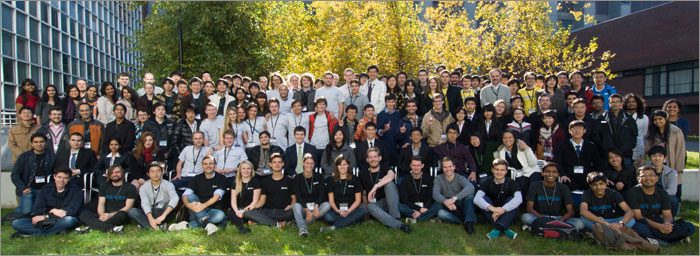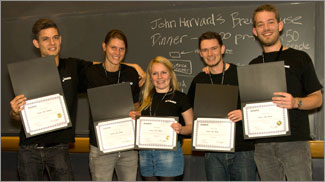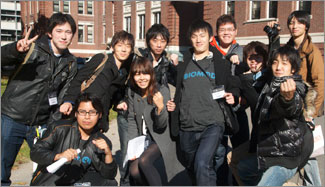In demonstrating that an RNA nanostructure can be designed as both a drug carrier and as an active therapeutic agent, the Danish Nano Artists took home the grand prize at BIOMOD 2011, the inaugural international biomolecular design competition hosted by the Wyss Institute for Biologically Inspired Engineering at Harvard University. Twenty-one undergraduate teams, representing more than 100 students from around the globe, competed in the event November 5.

The Wyss Institute created BIOMOD with the goal of introducing the next generation of scientists and engineers to bionanotechnology. The teams were challenged to devise projects in which biological molecules were engineered to assemble themselves into nanoscale structures, systems, or machines that could be programmed to perform useful scientific or technological tasks to help address real-world challenges.

Several project designs centered on devices that might one day target drug delivery to specific cell types in such a way as to reduce side effects when compared to traditional non-specific therapies. In one project, the team from the University of Texas, Austin, designed and developed a nanoscale machine that can count molecular inputs and release a signal once a threshold has been reached. Such a machine could help ensure precise dosing of drugs in the future. In another project, the team from Technische Universitaet in Munich, Germany developed a tool for measuring the binding of small molecules to DNA. Such a tool could help in the discovery of new antibiotics. (Videos for all the projects can be found at http://openwetware.org/wiki/Biomod/2011.)
The 21 teams determined the scope of their projects in the spring of 2011 and then spent the summer on project execution. Each team was responsible for raising the funds to cover its transportation to and from Boston. Among the countries represented were India, Slovenia, Peru, and Singapore.

Three teams from Japan overcame significant obstacles to reach Boston for the competition. In the wake of last March’s massive earthquake and tsunami, communication among the Japanese students was disrupted, and research activities were halted for several months as buildings and equipment were repaired. The Japanese teams represented Tokyo, Osaka, and Sendai, the city nearest the epicenter of the earthquake.
The five-member Danish team from Aarhus Universitet built on its country’s long tradition of melding form and function in designing an octahedron structure from RNA. Their innovation was to design the carrier itself as a drug that could be injected into the bloodstream where it would seek out its disease target and release its cargo. Second place was awarded to TeamJapan from Tokyo for its autonomous micrometer-sized molecular robot, and third place went to the HarvarDNAnos from Harvard for a rectangular structure that might one day encapsulate and release gold nanoparticles for therapeutic applications.
Awards were also given for Best Project Documentation, Best YouTube Video, and Best Presentation. The teams were judged by a jury of BIOMOD faculty mentors and outside experts including Wyss Institute core faculty members George Church, Ph.D., William Shih, Ph.D., and Peng Yin, Ph.D. The projects were ranked on the basis of content, Internet video, and live presentation. The live presentations took place on the Harvard campus in Cambridge. A full list of winners is available at http://biomod.net/winners.